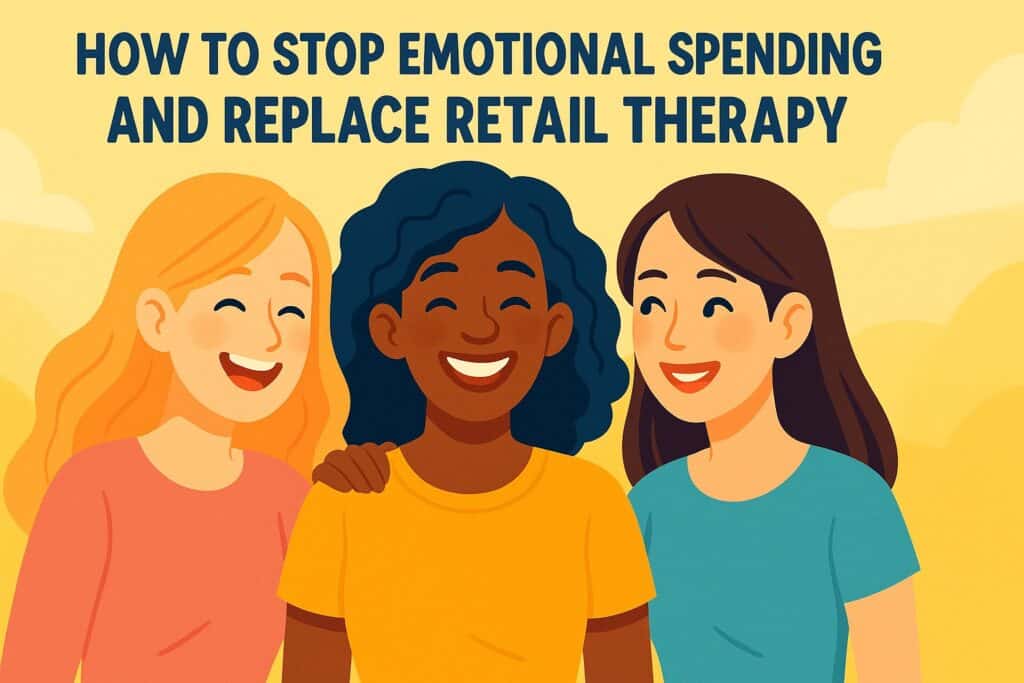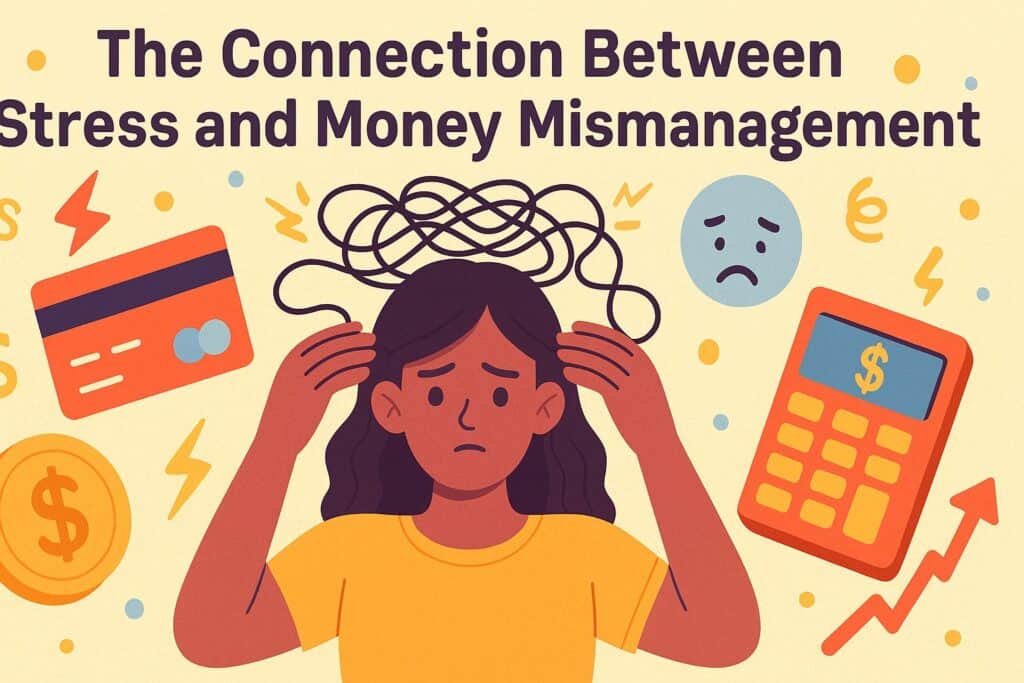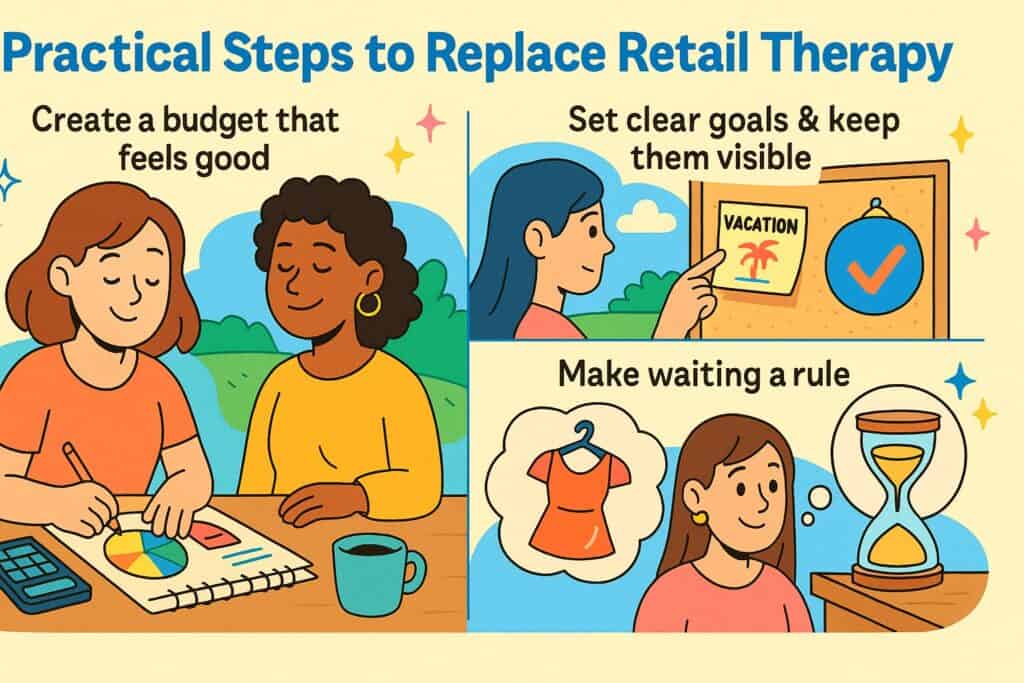I used to scroll through online stores late at night, convinced that adding a new “pick-me-up” to my cart was the solution to a stressful day.
The packages piled up, and so did my guilt and let’s not even talk about my bank account.
Sound familiar? For me, what started as harmless retail therapy quickly became a cycle of emotional spending that left me feeling overwhelmed and stuck.
It wasn’t until I took a hard look at my habits that I realized something had to change.
Trading those impulsive purchases for mindful choices did more than just help my wallet. It brought a sense of peace I didn’t know I was missing.
If you’re ready to stop emotional spending and start building a financial wellness journey that truly works for you, I’ve got practical tips and insights to share.
Understanding Retail Therapy and Its Emotional Root
Retail therapy can feel like a quick fix, a little burst of happiness after a rough day.
But have you ever wondered why splurging on that cute pair of shoes or impulsively snagging a sale item feels so good in the moment, yet weighs so heavily later?
Trust me, I know the cycle all too well. Let’s break down what’s really happening behind those late-night shopping sprees and how they might be impacting your life.
The Emotional Impact of Retail Therapy
“Retail therapy” is not just a catchy phrase. It’s a behavior deeply rooted in emotion. For many of us, shopping becomes a coping mechanism.
Feeling stressed at work? Maybe you’ve earned that “treat.” Lonely on a Friday night? A new outfit might bring some excitement.
But here’s the tricky part: these purchases often don’t solve the root of our struggles. Instead, they temporarily soothe feelings like loneliness, anxiety, or frustration.
Shopping provides instant gratification. Our brains release a dopamine hit, making us feel good in the short term, similar to indulging in comfort food or binge-watching a favorite show.
But that high fades quickly, often leaving behind buyer’s remorse or guilt.
Emotional spending is like putting a Band-Aid on a deeper wound. It covers the surface, but the issue is still there.
If this hits home, consider why you’re drawn to shop during certain emotional states. Are you celebrating, or self-soothing? Naming those emotions can be eye-opening.
For me, late-night scrolling wasn’t about the cute shoes in my cart, it was about filling a gap I hadn’t addressed.
Photo by Pavel Danilyuk
Recognizing the Financial Cost
While retail therapy offers a short-lived emotional lift, the financial consequences can be long-lasting.
The little purchases; those “cheap” items we justify, can quietly add up.
Before you know it, impulsive buys could take a big chunk out of savings or derail long-term financial goals. Sound familiar?
Let’s say you’re saving for a vacation or paying off debt, but a week of “treating yourself” totals $100. Do that consistently, and you’re losing thousands every year.
And it’s not just the dollar amount, it’s the missed opportunities for those funds to work harder for you, whether that’s through savings or smarter investments.
Emotional spending can also lead to a bigger issue: reliance on credit cards or debt to fund those purchases.
Over time, this can snowball into financial stress, which ironically, can lead to even more emotional spending. It’s a cycle that’s hard to break if you’re not aware of it.
To check how emotional spending is sneaking into your habits, track your purchases for a week. Seeing it in black and white can be jarring but empowering.
Need help cutting expenses without feeling deprived? My guide on How to Cut Your Expenses Without Sacrificing Happiness is a great place to start.
Recognizing the Signs of Emotional Spending
We all have our moments. A rough day at work, an argument with a friend, or just feeling off can lead us straight to the checkout screen.
Emotional spending often sneaks in disguised as “treating yourself,” but all too often, it leads to guilt and stress later on.
Let’s break down what triggers it and why it’s so hard to stop.
Situations That Trigger Overspending
It’s like clockwork. Something happens, and suddenly, you’re scrolling online or standing in line with a basket full of things you didn’t plan to buy.
What’s going on? It turns out, emotional spending usually kicks in during moments of vulnerability or high emotion.
Here are some common triggers that lead to overspending:
- Work stress: Deadlines piling up? A tough meeting? For many of us, that post-stress splurge feels like a “reward.”
- Relationship drama: Whether it’s a breakup or a fight with a loved one, shopping can feel like a way to reclaim control or comfort.
- Loneliness: Quiet nights alone can turn into hours of browsing, driven by the idea that something new might fill the emotional gap.
- Boredom: Sometimes, we’re not shopping because we need anything. We’re just trying to escape monotony.
- Social pressure: Ever feel like you “had to” buy a gift or participate in an expensive outing? That’s social spending. Part FOMO, part obligation.
Notice a pattern? The focus is rarely on the item itself. It’s about soothing an underlying need or emotion. But those “quick fixes” pile up, both physically (hello, unopened packages) and financially.
The Connection Between Stress and Money Mismanagement
Stress and emotional spending feed into each other like a never-ending loop. When we’re stressed, our brains crave relief and for many, spending provides that temporary sense of control and excitement.
But here’s the catch: once the novelty wears off, financial stress might follow, deepening the original anxiety.
According to Psychology Today, emotional spending creates a dopamine rush, much like a sugar high.
It feels good in the moment, but it’s fleeting. And the buy-now-pay-later culture doesn’t help.
Swiping a credit card to soothe emotions often leads to mounting debt, which only adds another layer of stress.
When you think about it, stress is like a knot in your finances, it tangles everything. Unchecked spending pulls on one end, while debt and anxiety tighten the other.
Breaking free starts with recognizing the pattern and making mindful changes, one dollar at a time.
How I Transitioned From Shopping to Saving
There was a time when my go-to remedy for a bad day was hitting the “add to cart” button.
It felt like every purchase was a step toward happiness, but it always left me in the same place: drowning in clutter and watching my savings disappear.
The shift away from retail therapy to real savings wasn’t a snap decision. It was a journey, and one I’m still thankful I took.
Let me walk you through my experience and the steps that helped me make this meaningful change.
The Turning Point in My Financial Wellness Journey
I’ll never forget the moment that changed everything. It wasn’t some big dramatic event or a rock-bottom moment.
Instead, it was a quiet Saturday morning when I sat down to check my credit card balance.
I wasn’t expecting surprises, but what I saw was sobering. Numbers that should’ve gone toward my future were scattered across expenses I barely remembered.
Random shoes, yet another trendy throw pillow, beauty products I hadn’t even opened.
It hit me: I was sacrificing long-term peace for short-term pleasure. That realization was both humbling and empowering.
I knew I had to stop emotional spending before it permanently derailed my goals.
From that point, I committed to reshaping my habits and figuring out why retail therapy had such a strong hold on me.
Practical Steps to Replace Retail Therapy
If you’re stuck in a retail therapy spiral, you might wonder where to even start. Here’s what worked for me and it’s all simple enough to try today:
- Create a budget that feels good: I didn’t just cut expenses randomly. Instead, I developed a spending plan that matched my priorities. I set aside money for savings, expenses, and a “fun fund,” a trick that helped me balance enjoyment and financial discipline. Need tips on creating a budget you’ll actually stick to? Read about ways to budget while reducing stress.
- Identify and replace emotional triggers: Shopping used to be my outlet for stress or boredom, but I found healthier ways to cope. Now, when I’m upset, I go for a walk, scribble in my journal, or call a friend.
- Set clear goals and keep them visible: Knowing I was saving for a dream vacation or a bigger financial cushion kept me laser-focused. I even stuck reminders like sticky notes on my desk or vision board to keep my “why” front and center.
- Make waiting a rule: I’d pause before buying anything unplanned. If I still wanted it a week later, I’d go for it. Most of the time, I didn’t even remember what it was by then.
Why Self-Care Was the Key to Breaking the Cycle
At the root of my retail therapy habit was something bigger: neglecting my own emotional needs.
Shopping wasn’t solving my problems. It was just distracting me from them. What turned the tide? Self-care. Real, meaningful self-care that didn’t rely on “stuff” to fill the gaps.
I began implementing small daily practices like mindfulness exercises, evening wind-down routines, and spending more time outdoors.
What I discovered was life-changing: meeting my emotional needs directly didn’t just break my shopping cycle. It boosted my entire sense of well-being.
True self-care became an investment in myself, not my things. If you’re looking for practices that heal rather than drain, explore 10 self-care practices to heal your emotional health.
Taking control of my finances was about reclaiming peace and joy in a way that retail therapy never could.
When I stopped chasing happiness in shopping bags, I realized what I truly craved wasn’t for sale at all.
Now, I’m building a life where financial independence and emotional balance go hand in hand.
If your budget or self-care routine could use a quick refresh, try out my Money and Self-Care Quiz. It helps uncover blind spots in your budgeting and aligns savings with your personality. And here’s the best part, it’s fun, no judgment involved!
Simple Techniques to Build Financial Wellness
If you’ve ever felt like keeping your finances in check is a never-ending battle, these steps can help you shift your mindset and lay the foundation for real peace of mind.
Creating a Savings Plan That Works
A good savings plan doesn’t just exist on paper, it fits your lifestyle and motivates you to stick with it.
The secret? Make it simple, flexible, and aligned with your goals. I used to think saving meant saying no to everything fun, but I’ve learned it’s about prioritizing what truly matters.
- Define your goals: What are you saving for? A vacation, a home, or an emergency fund? This clarity makes it easier to direct your money.
- Start small, but stay consistent: Even $10 a week adds up over time. Treat savings like another essential bill.
- Automate whenever possible: Set up automatic transfers to your savings account to avoid the temptation to spend first.
A well-thought-out plan is about giving yourself the freedom to spend on things that genuinely enhance your life.
For more tips on creating a sustainable savings routine, check out 10 Simple Tips to Achieve Financial Stability and Confidence.
Finding Joy in Non-Material Rewards
Emotional spending often fills a void, but it’s only temporary. Replacing the quick “high” from shopping with activities that offer lasting fulfillment is the game-changer here.
Let’s talk about finding happiness in ways that don’t involve pulling out your wallet.
- Explore hobbies you love. From painting to running, find something that calms your mind and gives you purpose.
- Invest in yourself through learning. Whether it’s picking up a new skill or reading a fascinating book, personal growth is its own reward.
- Spend time with loved ones. Heartfelt conversations, game nights, or shared laughter can be more satisfying (and cheaper) than retail therapy.
For me, building self-worth meant appreciating moments, not things.
Need some creative ideas? Head to 17 Easy Tips to Master Needs vs Wants for Mindful Spending to explore this further.
Tools and Resources to Support Your Journey
Taking charge of your finances can feel daunting, but the right tools and support make all the difference. Think of these as your sidekicks as you work toward financial balance.
- Budgeting Apps: Tools like Mint or You Need a Budget (YNAB) help you track spending and reach goals faster.
- Financial Communities: Join groups online or in person for encouragement and accountability.
- Educational Resources: Websites, podcasts, and blogs (yes, like this one) simplify complex financial topics into actionable steps.
And here’s something I’m especially excited to share with you: Take my Money and Self-Care Quiz to identify gaps in your budget and discover ways to align saving with your unique personality. It’s quick, free, and super insightful.
Developing financial wellness is not a one-time project; it’s an ongoing practice.
But with the right plan, some new habits, and even a fun quiz to keep things exciting, you’ll start to see a difference, not just in your bank account, but in your overall peace of mind.
How Financial Wellness Leads to Peace and Confidence
Having control over your finances doesn’t just lighten your wallet, it lightens your mind.
Money-related stress is one of the biggest hurdles to feeling truly at peace. But when you shift from “How will I afford this?” to “I’ve got this covered,” everything changes.
Financial wellness is about the freedom and confidence it brings to your life.
The Stress-Free Life of Savings
Imagine feeling like you’re always one step ahead of your bills, rather than two steps behind. That’s what financial clarity does. It lets you breathe.
When you know where your money is going, you can make decisions without the knot of stress in your stomach. You’re not playing catch-up; you’re in control.
Stress levels drop significantly when you create and stick to a savings plan. Why?
Because having savings is like owning an umbrella. It doesn’t stop the rain but keeps you from getting soaked.
That peace of mind allows you to focus on what truly makes you happy, like time with loved ones or pursuing hobbies without guilt.
Research has even highlighted the link between financial health and overall well-being.
People who actively manage their money report improved relationships, better sleep, and even stronger mental health.
It’s incredible how much lighter life feels when finances aren’t hanging over your head.
Need help getting started on a stress-free financial path? Explore simple self-care practices to start boosting your happiness while tackling your finances.
Building Confidence Through Financial Independence
One of the most empowering feelings is knowing you’ve got your own back. Managing your finances is like strength training for your self-esteem.
Each time you pay off debt, hit a savings goal, or stick to your budget, you prove to yourself how capable you are.
Financial independence allows you to make decisions without relying on others. It also opens doors to experiences and opportunities you might have thought were out of reach.
Whether it’s traveling solo or investing in your personal growth, having your finances sorted gives you the freedom to say “yes” to things that truly matter.
Confidence also comes from understanding your money. When you take the time to learn about budgeting or investments, you’re building a foundation of knowledge that eliminates uncertainty.
It’s like finally knowing the rules of a board game. You can play to win.
If you’re looking for more ways to boost your confidence, check out this guide on confidence and self-esteem. Remember, managing money is just one piece of the puzzle. Confidence is about how you feel inside and out.
Taking control of your finances doesn’t just change your bank account.
It changes how you show up in the world, with peace, pride, and the confidence to take on anything.
For more insights into maintaining balance and clarity, check out the Stress Management blog.
Final Thoughts – From Retail Therapy to Real Savings: How to Stop Emotional Spending
Letting go of emotional spending is about claiming the peace and freedom that comes with true financial wellness.
Through swapping my late-night shopping habits for intentional practices, I’ve built a life that feels richer and more fulfilling—without needing to rely on purchases for happiness.
If you’ve ever felt like emotional spending controls you more than you control it, there’s hope. It all starts with recognizing the behavior, taking small steps, and finding joy in things that don’t come with a price tag.
You deserve to feel empowered in your finances, confident in your decisions, and supported on this journey toward balance.
If you are ready to explore what financial wellness could look like for you, take my Money and Self-Care Quiz to discover personalized tips that fit your lifestyle.
And if you’re looking for even more inspiration, dive into ways to define success and happiness in your everyday life.
If you are looking for more ways to balance joy and smart money habits, check out how a Fun Fund can transform your self-care and savings.
Your transformation is waiting. Every small step you take today is shaping the wealth and serenity you’ll enjoy tomorrow.
Self-Care
Love what you just read? Share it with someone who could use a little more self-care and breathing space in their life. Pin it, text it, or drop it in a group chat.
Your support helps us grow a kind, empowering space for women who are ready to put themselves first.
Money Matters
Feeling inspired to take charge of your finances? Pass it on. Share this with a friend who’s ready to ditch the money stress and start making empowered choices.
Pin it, text it, or drop it in a group chat. Every share helps us build a community of women rewriting their money stories.
Confidence & Self-Esteem
Feeling inspired and ready to shine brighter? Spread the confidence! Share this with someone who could use a gentle reminder of their worth and strength. Pin it, text it, or drop it in a group chat.
Every subscription and share helps us build a supportive, uplifting community of women stepping boldly into their best selves.
Let’s create routines and make smart moves that feel empowering—together.






